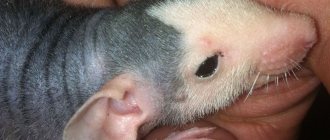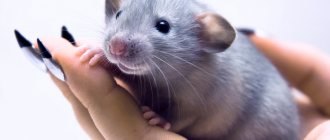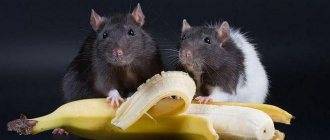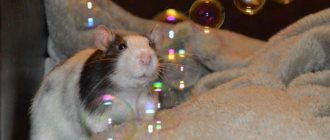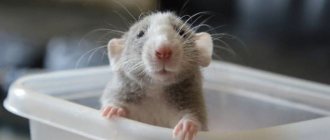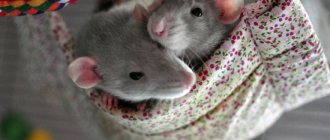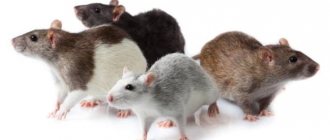- home
- Rat
- Good to know
06/21/2019 Wild rats, or pasyuks, as they are also called, can hardly be called welcome guests - these rodents pose a serious danger. They raid food products and, making their way to them, chew through everything - from wood to concrete and even metal. In addition, these animals often act as distributors of infectious infections. It is difficult to protect yourself from pasyuki, but it is possible. One of the most important stages in the fight against wild rodent pests is the detection of their homes. In summer, finding enemy nests is problematic, but in winter, rat tracks left in the snow will lead to them.
Rats' habitat is vast
Rats thrive in most environments where food and shelter are available. Norway rats can be found in homes, warehouses, office buildings, sheds, basements, sewers, landfills and other places that provide ample food. They dig holes in the ground for shelter, nesting and food storage. Burrows usually start next to buildings, fences, or other cover. Black rats do not usually dig burrows; they are found above ground level: in trees, rocks, attics, upper levels of warehouses, wall cavities and roofs.
War of blacks and grays
Once upon a time, black rats reigned supreme in Europe. They were known about and destroyed back in the ancient period, and in the Middle Ages they even organized teams of professional rat catchers. Despite all efforts, in the 14th century, millions of people died from a plague carried by black rats.
They are smaller than gray ones, do not like to move long distances and live in basements, preferring to live in attics and roofs. Now in cities the gray rat is replacing the black one, since it turned out to be less intelligent and weaker. If there is enough food, the grays do not bother their black brothers and crowd them out only when there is a shortage of food. In settlements remote from the sea, for example in Moscow, there are very few black rats left, but in coastal cities their numbers are huge, and on ships they still dominate.
Rats can squeeze through anywhere
A rat can squeeze through a hole the size of a quarter thanks to its collapsible skeleton. Its ribs are hinged to its spine and can fold up like an umbrella, meaning that any opening large enough for a rat's head is large enough for the rest of its body.
Photo: www, pestologyltd.co.uk
Rats can even chew their way through thick wood, metal pipes, brick walls and cement. Their front teeth are long - they grow about 12-13 cm per year - and also very sharp. To keep their teeth from becoming too long, rats must constantly chew on hard objects and sharpen the edges of their upper and lower teeth against each other, like a knife on a whetstone. The teeth will eventually grow into the brain if rats stop sharpening them.
Pasyuk paw prints
Rat tracks are striking in their variety, often reminiscent of paw prints of other inhabitants of fields and forests.
Normal step
It is not difficult to distinguish a rat and a mouse by their tracks. The plantar tubercles are clearly visible in the snow. Their size is significantly less than the length of the animal’s foot:
- the rear sole is 4 cm, only its front part remains on the snowy clearing;
- rat paw prints measuring 2*2 cm;
- fingers 1 cm long with sharp claws;
- A characteristic feature is 5 fingers with a widely spaced side one.
Walking in an unfamiliar area
The animal moves carefully, exploring every centimeter. Paw markings are placed alternately in pairs. First, the deepening of the front foot, followed by the back foot on the same side. Another pair of limbs is located nearby in a checkerboard pattern. The interval between each pair is about 8 cm. The width of the track is no more than 3 cm. It moves smoothly, as if there is a pointer thread in front.
Rats are excellent athletes
The long claws on a rat's paws allow the rodent to scale brick or cement walls with the ease of Spider-Man. Getting down is also not a problem: a rat can fall from a height of 15 meters and land on its paws without injury. They are also phenomenal jumpers: rats can jump up to 60 cm in height from a standing position. According to one study, rats can lift objects that weigh almost 0.5 kg - more than the average body weight of a rodent.
Rats are able to stay in water for three days in a row (in laboratory conditions) and hold their breath under water for up to three minutes. This means they can swim through sewer pipes, squeeze through water pipes, and lick through a hole in a toilet. There are species that can swim more than 1.6 km without resting!
Benefits and harms
It is believed that a small gray rat is capable of leaving a sixth of the world’s population without food (photos of rodents are presented in the article). An adult needs only 20 g of food per day, but over the course of a year this figure increases to 10-12 kg. If you remember that there are now almost 18 billion rats on the planet, you can imagine how much food they eat.
Rats can infect humans with such deadly diseases as plague, Q fever, typhus, as well as non-lethal, but also very dangerous helminths, staphylococci and streptococci.
These animals spoil things, furniture, leave houses and even entire villages without electricity, gnawing through electrical wiring.
And yet they bring us benefits that are difficult to overestimate. Geneticists have found that the genes of humans and gray rats have more in common than those of humans and monkeys. This makes it possible to carry out highly complex genetic research, which is also facilitated by the incredibly fast reproduction of rodents. Scientists are testing new medications on them, studying many deadly diseases in order to understand how to treat us humans. Therefore, rats deserve not only hatred, but also respect.
Rats size XXL
On average, a rat is about 40 cm long (including the tail) and weighs 450 grams. If a rat lives near a permanent food source, such as a trash can, it can grow up to 50 cm in length and weigh 0.9 kg. But this is insignificant compared to the Bosavi woolly rat, which was discovered in 2009 by a BBC expedition on the territory of an extinct volcano in Papua New Guinea. The animal was 81 cm long (including the tail) weighed more than 1.36 kg and showed no fear of people. It is believed to be one of the largest rats in the world. However, don't be afraid to meet it on the street: the rat, which scientists believe belongs to the genus Mallomys, lives only in the area of the volcano.
Photo: www.animals.fandom.com
Unfortunately, scientific research has shown that regular rats are getting larger. On the other hand, researchers believe that physiology will not allow them to turn into giant rats. They will most likely never exceed 1 kg.
Cute dachshund
This story happened in Russia almost 28 years ago. The country's rich people, in search of constant exotic innovations, often got a dachshund dog, which was inaccessible to average Russians.
One day, one woman bought such a dachshund for her family and, as if nothing had happened, walked down the street with it. The dog was very active and mischievous, she constantly ran along the street, sniffed out something and played. Soon children began to gather around the dachshund. She was so kind and affectionate that the owner never worried that her dog could harm others.
They have very sensitive taste buds
Poisoning a rat is not easy. Animals can detect infinitesimal amounts of poison in food—as little as one part in a million. It's like finding a teaspoon of cocoa in 5,909 liters of milk. Rats are also wary when eating unfamiliar food; they start by tasting a tiny piece of food to make sure that the food is harmless.
Sometimes rats bite sleeping people on the face and hands at night, attracted by food debris on human skin. Once a rat bites a person, the chances of it biting people again increases. It's like finding a new favorite dish and ordering it at every restaurant you visit.
Nutrition
What does this rodent eat? The gray rat is an omnivore. In nature, its diet consists of insects, lizards, chicks, bird eggs, cereals, root vegetables, and fruits. Rodents living near water eat small fish, mollusks, and crustaceans. Rats that settle in populated areas eat everything that they can steal from a person - any prepared food, any products, garbage, leftovers. It’s hard to understand why, but they chew paper, clothes, shoes, polystyrene foam, wooden products, electrical wiring - in short, everything that their powerful teeth can bite through. In villages, these little monsters eat chickens, newborn rabbits, and bite off the paws of adult rabbits that are locked in small cages. Male rats even eat their own children. Females are a little kinder; they eat only those babies that seem weak to them. They can survive only 4-5 days without food.
The rat has an incredible sense of smell
They have a hypersensitive nose and are especially sensitive to unpleasant odors, which can cause respiratory distress. These small rodents have a nose with 1,207 olfactory receptor genes. They come just behind elephants (1,948 genes) but are far ahead of humans (396 genes) and dogs (811 genes).
Photo: Oxana Kuznetsova
This is likely due to the fact that rats have evolved a sense of smell to be able to sniff out hidden food sources. Rat Nose is so good that it helped clear landmines from Mozambique, and they are now clearing landmines in Cambodia, Zimbabwe and Angola. The rats themselves are too small to detonate the mines, so they are completely safe. The rats simply point out where the explosives are buried so that the mine can be safely detonated.
Possibility of attacks on people
Whether a rat can attack a person is a pressing question. Every year, hundreds of cases of rodents attacking people and leaving bites are recorded around the world.
The risk of being bitten increases in areas where the number of rodents exceeds acceptable limits. An increase in population provokes malnutrition and hunger. This is the main reason for the aggressive behavior of rodents. Rats can attack large mammals, birds, and humans in a hopeless situation:
- if a rodent is cornered, you need to protect your life;
- aggressive behavior is associated with an unbearable feeling of hunger;
- the animal has rabies.
Before jumping on a person, the animal takes a characteristic pose. It rises on its hind legs and a grin appears on its muzzle. Attacks with a jump. It can bite on the legs, arms, and grabs small children by the neck. A rat attacks a person with particular cruelty. An extremely dangerous situation when you have to defend yourself from several rodents.
On a note!
A rat is capable of attacking a person if it feels his helplessness, his superiority. It can calmly bite a sleeping person, a sick person bedridden, or a small child. In most cases, the animal tries to avoid a fight with a person and flees.
Rat bites A rabid rat bites a person with particular aggressiveness. As the disease progresses, the sense of caution disappears, and the animal mindlessly rushes to attack all living beings. Outwardly, it is distinguished from a healthy rat by the presence of saliva that flows from its mouth and redness of the eyes.
Interesting!
A rodent that has entered human territory will not just attack. The animal behaves cautiously, comes out at night, and tries to quickly hide at the sight of people. If a person finds himself in an area where a rat feels like a master, the situation is different. Rodents try to bite prisoners in prison, homeless people, and plumbers.
Rats are very sociable
In the wild, rats tend to live in groups of five, often living in close proximity to other rat families. In areas of low density there is one male per group, which is highly territorial. He is the only mating partner for females. In areas of higher density, males tend to be less territorial, and there may be several males in a group.
These rodents also love human company and may respond to their name. Rats are easy to train. Just like dogs, they will do anything for a tasty treat. They enjoy the interaction they get from doing things like searching, jumping, and coming when called.
The rats laugh, but we don't hear it
Rats make high-pitched chirping sounds (especially when tickled), but humans cannot hear them. Rats communicate at a very high frequency, above 50 kilohertz, so we unfortunately cannot hear their laughter without the help of a bat detection device. Rats especially love to be tickled on the back of their heads. When happy, they chatter or grind their teeth, accompanied by eye twitching. But they will stop laughing when conditions change, such as a bright light or the smell of an approaching cat. Research shows that primates such as bonobos and chimpanzees, dogs and dolphins can also laugh.
In Novosibirsk there is a monument to laboratory rats and mice
Photo: Irina Gelbukh / Wikimedi
The monument, 1.82 meters high, is located in the courtyard of the Institute of Cytology and Genetics in Novosibirsk. A bronze rodent knitting a DNA double helix, with a small pince-nez on its nose, is installed in memory of the rodents used in laboratory tests. Between 85 and 95% of animals used in laboratories are rodents, including rats, mice, hamsters and gerbils. In the United States alone, 100 million rodents are tested annually.
Rats are known carriers of disease.
They were involved in the spread of about 40 diseases: bubonic plague, typhus, leptospirosis, hemorrhagic fever, salmonella, tapeworm, etc. There are many ways that people or pets can contract the above diseases from rats: rodent bites/scratches, ingestion of contaminated food or water, inhalation of contaminated dust, direct contact with an infected rodent, and bites from infected fleas or ticks.
For many years, rats with plague-infected fleas were thought to have caused the Black Death (1347–1351). The pandemic has killed about 25 million people in Europe, almost a third of the European population. However, recent research suggests that another rodent is to blame for the Black Death: gerbils. The wet conditions of the time caused gerbils, not rats, to flourish. In addition, the distemper virus can be carried by a variety of animals, including cats, dogs, camels, sheep, goats, chipmunks and squirrels. In fact, more than 200 animals are considered carriers of bubonic plague.
History of origin and settlement
Paleontologists have found that the gray rat species appeared in the Pleistocene, that is, approximately 2.5 million years ago. Other rodents, including mice, already existed by that time. The next ice age that began killed many of them, but gave the gray rat the opportunity to establish itself as the most progressive species. In those distant times, these animals lived only in the territory of modern China.
From the south and east their habitat was limited by seas and oceans, from the west by insurmountable mountains, and from the north by a glacier. When it began to melt, the rats moved to new lands. Colonization proceeded unusually slowly. For more than 13 thousand years, they only reached the present-day Transbaikalia, where to this day they live well in natural conditions. Rats were encouraged to spread across the planet by people who began to actively engage in trade and navigation. About 2,000 years ago, tailed stowaways entered India on ships, from there they got to Persia, and then moved to Europe, America, Africa, and Australia. Now they are not found only in places where they have absolutely nothing to eat - in Antarctica, in the Arctic and in certain areas of the desert.
They have incredible fertility
When it comes to reproduction, rats leave rabbits far behind. When they are not eating, they usually mate. During one six-hour receptive period, a female rat can mate up to 500 times, which helps explain how a pair of rats can eventually produce 15,000 offspring in one year and why they are the most widespread mammal in the world.
Photo: www.squeaksandnibbles.com
Rats reach reproductive age five weeks after birth, and continue to reproduce until about two years of age. Gestation usually lasts about three weeks, and litter sizes range from 6 to 20 pups. Peak reproduction occurs in spring and autumn.
In China, rats are highly valued.
Rats are considered smart and quick-witted animals, capable of surviving everything that life throws at them - be it earthquakes, famine or war. According to Chinese zodiac legend, when the Jade Emperor invited the animals to a feast, the Rat mounted the Ox and jumped off as soon as they arrived, finishing first. Rats are also considered wealth animals and are revered as symbols of fertility in China. The ancient Egyptians and Mayans also worshiped rats. And people born in the year of the Rat are traditionally considered cunning, witty and wealthy.
Fact 1 Teeth grow continuously
For this reason, it is vital for them to constantly chew on something. If you do not allow rodents to grind down their fangs, they can grow up to 12 centimeters, which will result in the death of the animal. Therefore, they gnaw on almost everything: it will not be difficult for them to gnaw a hole, for example, in a concrete wall or a steel water pipe. Here is a list of materials that cannot resist toothy pests:
- Concrete;
- Metal (except iron, as well as especially durable metals);
- Tree;
- Stone;
- Plastic and plastic.
The only material that in its natural form is too tough for our little animals is glass.
Source
Did you know?
- All rats belong to the genus Rattus, which includes 51 species.
- Rats don't sweat. They only have sweat glands on the skin of their paws, which are not sufficient for cooling. To regulate their body temperature, they constrict or dilate the blood vessels in their hairless tails.
- The lifespan of a rat depends on whether it is a wild animal or a domestic animal. Rats kept in captivity can live up to 4 years. In the wild, they typically live 2-3 years. They are hunted by owls, hawks, snakes, dogs, cats and other predators.
- Rats have very poor eyesight. They also suffer from color blindness.
- A rat can go without water longer than a camel. Surprisingly, the kangaroo rat (genus Dipodomys) can spend its entire life in the desert without drinking water. It receives most of the moisture it needs from seeds.
- A rat's heart beats 650 times a minute!
- Cedar and pine oils are toxic to rats and should not be used as bedding.
- Rats were among the first animal astronauts. In 1961, France launched a rocket into space with a rat on board.
- Rats are clean people. Rodents, so often associated with sewers and garbage cans, are actually very clean animals. They spend several hours a day cleaning.
- The Dumbo Rat is a fancy rat with large, round ears that give it a cute teddy bear appearance, making it a very popular pet.
Health
While rats are generally tough little creatures, they are certainly subject to a number of risks. Some of them, such as kidney disease and obesity-related conditions, can be prevented with proper management and diet. Others, such as tumors and respiratory diseases, are a combination of genetic predisposition, exposure and environmental factors. Although an animal may have a large tumor, there are often ways to improve the animal's quality of life even when there is no cure.
Mammary adenomas are the most common mammary tumors in rats and can be found in males and females. Sterilization can significantly reduce their incidence in females. Although they have been reported in rats of all ages, they are most common in animals older than 18 months.
Respiratory illnesses are one of the most common reasons why pet rat owners visit a veterinarian. There are several main causes of infection, including bacterial, viral, fungal and parasitic diseases. Infections often have serious and severe secondary consequences, including pneumonia, abscesses, empyema, pleural effusion, and bacteremia.
Of all the causes of pneumonia in rats, the most common is the bacterium Mycoplasma pulmonis. Clinical signs vary depending on the virulence of the strain, site of infection, age of the animal and concomitant disease. In fact, many owners take their rat to the doctor thinking it has an eye disease and complain that the animal is squinting and bleeding from its eyes. These animals are often clinically ill and may appear lethargic or have poor appetite, poor coat coat, weight loss, stooped posture, and grumpy behavior. Some rats show no signs at all.
